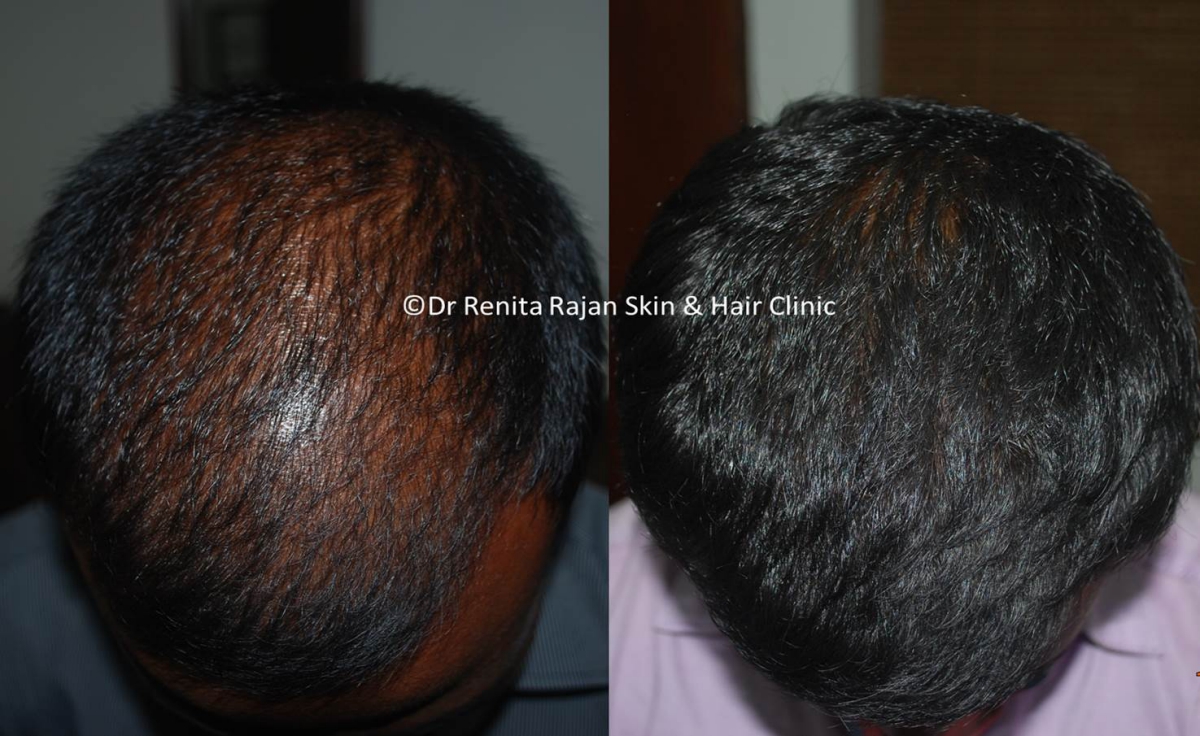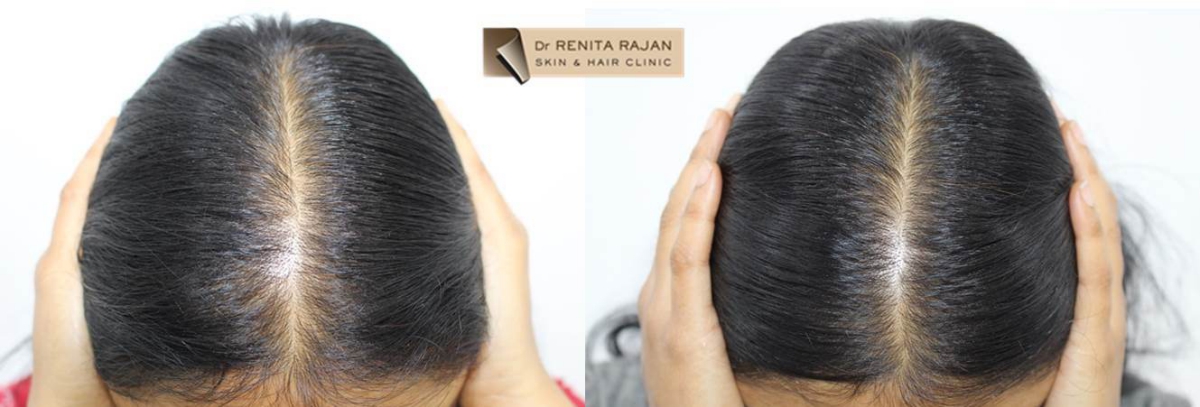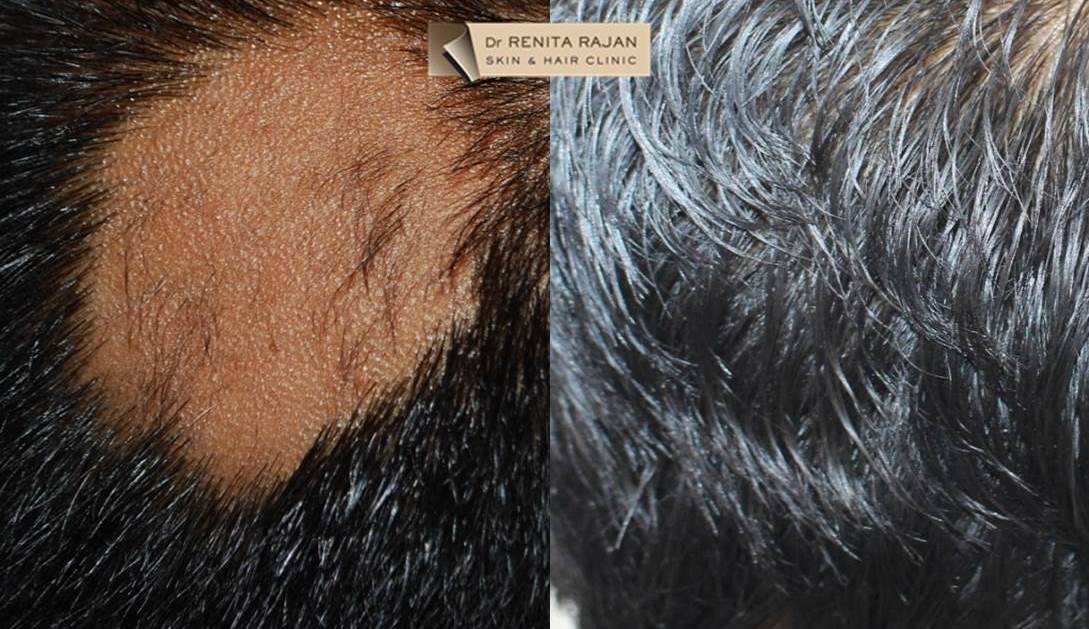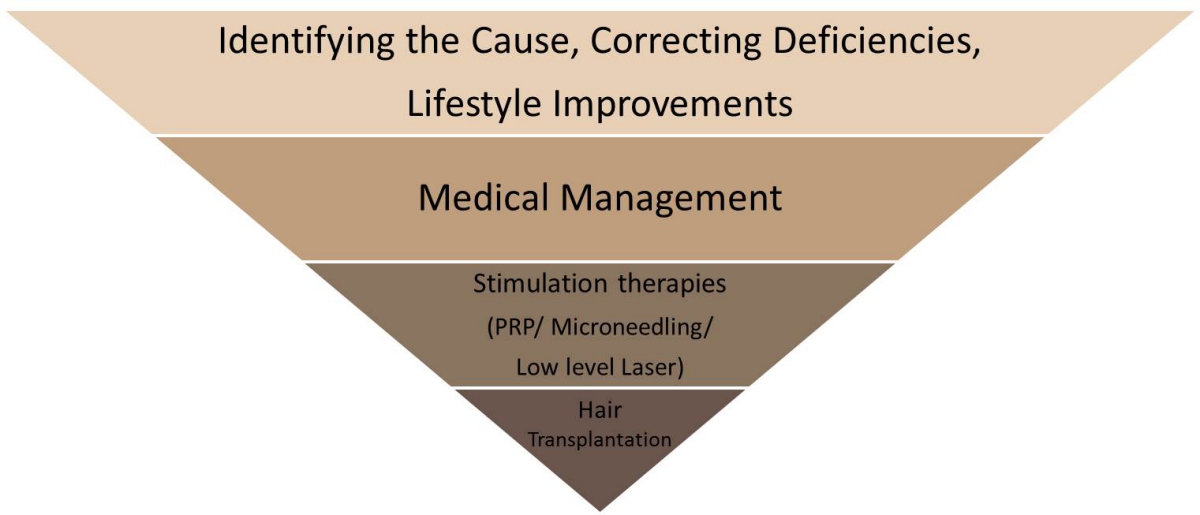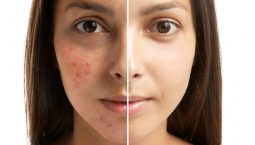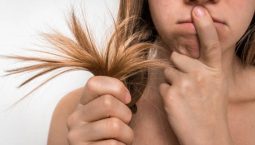Hair loss, both in men and women can be due to multiple causes, which depend on both genetic and environmental factors as well as co-existing medical conditions. Some of the common causes are mentioned below. At Dr Renita Rajan Skin & Hair Clinic, we hope to identify the causes first, before we proceed with managing the loss. Even though, the bulk of our hair loss patients suffer from androgenetic hair loss or pattern balding, we make it a point to look for any additional causes/ overlap of other diseases, in every single person, who approaches us for help with hair loss. We commonly use a trichoscopy, to help us diagnose the condition, but when required, we may proceed to a do a biopsy as well. Again, since micro-nutrient deficiencies do play a role, more so in women, we advise blood tests*, whenever required.
Hair loss occurs in a characteristic way with recession of hairline, and thinning of density over the front and the sides of the scalp, with or without additional loss over the crown. Here, the primary reason for hair loss is due to genetically mediated, increased activity of androgens (commonly referred to as male hormones). These act upon specific receptors in the hair bearing regions of the scalp, causing a decrease in the density and the thickness of individual hairs. The characteristic pattern of balding that is commonly noted is due to the distribution of these receptors in a particular fashion on the scalp.
This is being seen more and more commonly, of late – possibly reflecting the increased incidence of hormonal conditions like PCOS (Polycystic Ovary Syndrome) in the population. Hair loss occurs primarily along the frontal area in a Christmas tree pattern, with or without a recession of the temporal hairline. This pattern of hair loss, necessitates a need for a detailed evaluation, and often requires a maintenance therapy once the initial phase of treatment has successfully arrested hair shedding.
This type of hair loss is immune mediated, with the hair loss occurring due to the destruction of the follicles by our own immune cells. In most cases, it is limited to a few patches, but in some patients the condition may progress to involve newer areas. The treatment of choice in patients with a limited number of patches is intralesional steroid injections. In the more advanced cases, oral immunosuppressive medications are often required, sometimes, for prolonged periods. PRP has been shown to be of some help, and we do use this modality as adjunctive therapy.
Other conditions include acute and chronic telogen effluvium, as in the case of hair loss post pregnancy. While for most individuals it is an acute occurrence, for some, the condition may persist to become chronic. Fungal infections can be associated with patchy hair loss, and can be easily treated with oral medications and topical applications. Trichotillomania is a condition where the patient pulls out his/ her own hair, impulsively. Management involves treating the underlying psychological issue, with/ without medications. Traction alopecia is very common due to the traditional hairstyles that pull and twist the hair into plaits/ pigtails or ponytails. With prolonged traction, this could lead to permanent hair loss. Scarring alopecias are conditions where the hair follicle is irreversibly destroyed, either as an immune phenomenon, trauma or due to infections. These may require a biopsy to establish a diagnosis, and in cases where it may impossible to grow hair back, we offer a hair transplantation once the disease process is confirmed to be burnt out. For hair loss resulting from trauma, hair transplantation is a very good option to restore cosmesis. Even though alopecia areata is a form of non scarring alopecia, in refractory cases where all treatments have failed, hair transplantation may still be considered to provide relief to the patient.
Scalp Microneedling: This is a very useful treatment option, that is employed as the first line of management in our Clinic, along with topical agents. Planned for 6 to 12 weeks, depending on the severity of shedding, this treatment helps control shedding of hair, and promotes regrowth. This treatment is used for both men, and women with hair loss, and has been innovatively developed in house, and has shown significant promise. Maintenance is continued once the initial cycles are completed, usually with DIY topical applications.
Platelet Rich Plasma Therapy: This modality stimulates the hair stem cells, and help in hair rejuvenation – with a resultant increase in hair density and diameter. A relatively new and innovative treatment, this makes use of the patients’ own blood to generate the growth factor rich PRP.
Medical Management: This has been our forte for managing most cases of hair loss, especially when topical / adjuvant treatments have not been of sufficient help. More often, depending on the severity of hair loss, these treatments may be initiated along with adjuvant/ topical treatments.
Low Level Laser Therapy : Studies have shown the efficiacy of this treatment in increasing the hair count, and decreasing shedding. However, this is an adjuvant treatment, and is often not adequate as a stand alone option.
*Please note that the blood tests may be performed in any lab of your choice,as long as it is a certified centre. We do not have any preference for any particular lab, and since some tests are required to be done on an empty stomach, it may make more sense to have the tests done at a lab closer to your residence. Also, if you have done any tests in the past 6 months, please make sure to bring the same, when you come in for your scheduled consultation. If the tests are found to be valid, we are good to go with the same.

